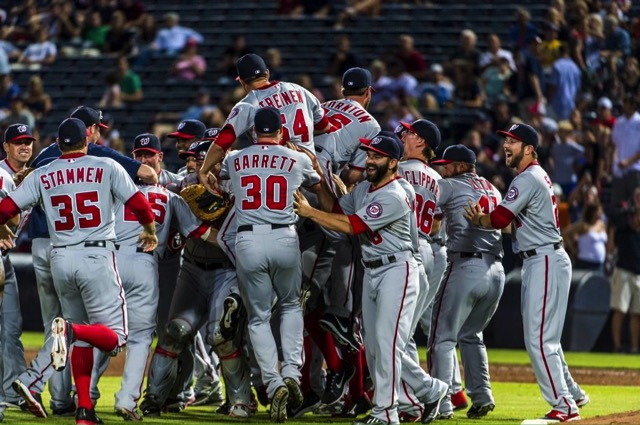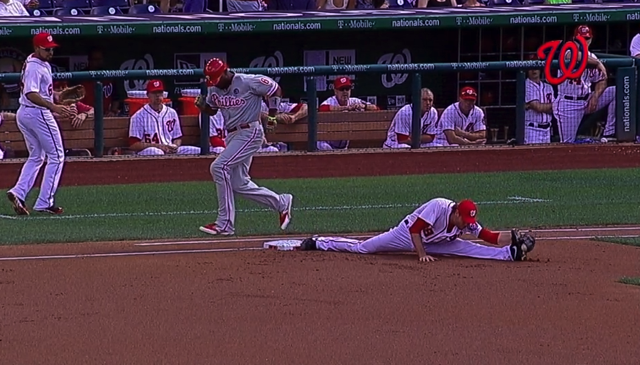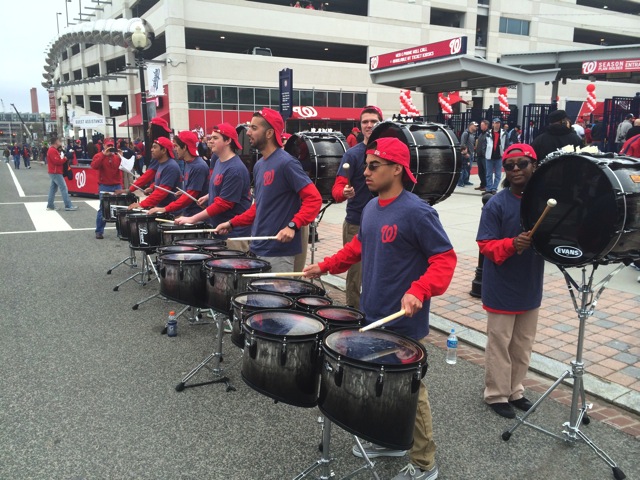With Gio Gonzalez bound for the disabled list with inflammation in his shoulder, he joins Ryan Zimmerman, Adam LaRoche, Bryce Harper, Doug Fister (returned), Wilson Ramos (returned) as part of the Nationals’ squad of walking wounded at the quarter-season mark. After 42 games, the only welcome surprise is that the Nationals are over .500 and just half a game back of the slumping Atlanta Braves.
Fortunately for Nationals fans, however, this is a team with flexible roles and a lot of “spare parts” that have blunted the pace of injuries visited upon the starting lineup. Usually, this is where I’d start looking for patterns in the injuries, hoping to find some clear path of neglect or overuse, but on that front, you just have to admit that the Nationals have been cursed/snakebit/deeply unlucky. Zimmerman, Ramos and Harper were each injured in standard plays that just went badly awry. Fister had a slow start related to an early season strain, and LaRoche’s quad strain is, at least according to the man himself, feeling “shockingly” good. While the jury’s still out on the severity of Gio’s shoulder trouble, at least this looks like dumb luck and not a horrific trend.
So what’s working right now? As of Sunday, Tyler Clippard has 9 2/3 innings of scoreless ball, representing a much-needed rebound for the Nationals’ bullpen. His early appearances were the source of agita for Matt Williams and Nationals’ fans alike, so a return to his usual level of singular dominance has been excellent. Jayson Werth’s veteran presence in the outfield has been nothing short of spectacular. He’s played in every game – one of just three Nats to do so (Rendon and Desmond are the other two) – and has an .835 OPS to show for the experience.
Tanner Roark’s WHIP of 1.095 after eight starts is nothing to turn up your nose at. While his 3-1 record is tied with Jordan Zimmermann for best record on the Nats, his 20 runs allowed is the lowest on the staff. After just 9 starts, Stephen Strasburg has 70 strikeouts – on pace for more than 300 on the year – which shows that his fastball/changeup 1-2 punch can be utterly dumbfounding for the opposition, and he’s just 6 back of the league lead.
And what’s not quite working so well? While the bench has performed admirably, especially Danny Espinosa, there are some real problems with the Nationals’ state of play in the field. Ian Desmond has reverted to earlier form at short, making errors of commission that most other shortstops would let through for hits, and that’s something that’s going to have to be fixed. What that means for the young infielder is less than clear at this time. Desmond’s also had a slow start at the plate, and that certainly can’t help his focus.
With Harper out, the Nationals have turned to Nate McLouth and Kevin Frandsen in left. If you’re confused by the concept of infielders playing outfield, welcome to modern baseball, where the rules are made up and the positions don’t matter! But in all seriousness, trading Harper’s exuberant and athletic defense in left for McLouth’s bat and Frandsen’s quick adaptation process is a downgrade of serious concern. In addition the Nationals’ offense is once again in Feast or Famine mode. In aggregate, they stand in the middle of the pack for rush scored and runs allowed, but have been shutout three times, and held to two runs or less in a third of their contests thus far, and have scored more than 5 runs in a third of their game (winning all but one).
Where are the improvements going to come from? Well, to start, none of the injuries we’ve seen from the 2014 Nationals are season-enders. Ryan Zimmerman is due back in the coming weeks, and though there’s talk of him taking over in left until Harper is healthy, he won’t be the worst Nationals they’ve run out to that position. It’s a warning, in part, to Denard Span, who’s struggled in the leadoff slot. We know Harper’s got the range to play center, and it’s entirely possible that if Zimmerman is hitting, and Span isn’t, an outfield of Zimmerman, Harper and Werth is entirely possible. Zimmerman surely couldn’t be any worse than Michael Morse was.
As Doug Fister readapts to the big leagues, he will be a vast improvement over the early struggles of Taylor Jordan, and barring another injury, that upgrade will be substantial. A full set of starters will make the bullpen’s job substantially easier, as well.
This is a ball club that’s still in the thick of it, despite losing their best bat so far this season, their youngest phenom, the face of the franchise, their newest starting pitcher and their power stroke catcher. When you look at their result – half a game back of first, three games over .500, it’s hard to see anything but the potential upside of a healthy squad.



